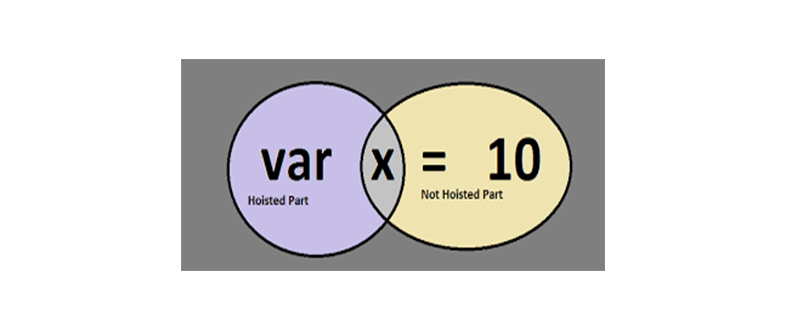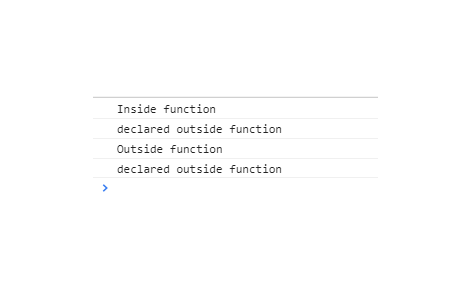How to understand variable hoisting in JavaScript
Variable promotion in JavaScript means that the declarations of variables and functions will move to the front of the code, but in fact the locations of the declarations of variables and functions will not move, they are just placed in memory during the compilation process.
Although JavaScript is an interpreted language, an important step in web development before execution is for the interpreter to browse the code and identify all variables declared, note when they are reassigned, and Divide code blocks into three levels of scope: block, function, and global. Next, I will introduce variable promotion in JavaScript in detail. I hope it will be helpful to you

[Recommended course: JavaScriptTutorial】
Example:
function exampleFunction() {
var x = "declared inside function";
console.log("Inside function");
console.log(x);
}
console.log(x);Rendering:

The scope of the function in the above example includes the variable x, so the variable is only known within the function. If you access it in the global scope, an error will be reported because x is not a declared variable.
If you move the declaration of x outside the function, it will be in the global scope and available outside or inside the function.
Example
var x = "declared outside function";
exampleFunction();
function exampleFunction() {
console.log("Inside function");
console.log(x);}
console.log("Outside function");
console.log(x);Rendering:

With the emergence of ES6, Two new methods of promoting variables are introduced: let and const methods. These methods provide more fine-grained control over the range available to the variable. Local variables defined by let and const can only be used in the level where they are defined.
Variable promotion
In the following example, x declares var , and x calls the same variable in the entire function and in the sub-block. If x is declared with let or const, then the external scope will not be able to access it, if we declare let x again in the submodule; in fact it is a different variable
function varTest() {
var x = 1;
if (true) {
var x = 2;
console.log(x); // 2
}
console.log(x); // 2
}
function letTest() {
let x = 1;
if (true) {
let x = 2;
console.log(x); // 2
}
console.log(x); // 1}Example:
function doSomething() {
console.log(bar); // undefined
console.log(foo); // ReferenceError
var bar = 1;
let foo = 2;}In this function, the declaration bar is promoted to the top of the scope. In fact, it is executed like this:
function doSomething() {
var bar;
console.log(bar); // undefined
console.log(foo); // ReferenceError
bar = 1;
let foo = 2;}This is why the result of console.log(bar) is undefined, and console.log(foo) will report an error
This makes such a thing Possibly:
num = 6; console.log(num); // returns 6 var num;
and:
dogName("Watson");
function dogName(name) {
console.log("My dog's name is " + name);
}In the first example, although the var num is declared after the assignment, from the computer's perspective, it Noting that we have declared it globally, we move the declaration to the top and continue executing the rest of the code. In the second example, even if we call/call the function before defining it, the definition is hoisted to the top of the scope, so by the time we actually start executing the code, the interpreter already knows what it is dogName() .
Note: For var variables, only the declaration is promoted, not the assignment.
Summary: The above is the entire content of this article. I hope it will be helpful to everyone in learning variable improvement.
The above is the detailed content of How to understand variable hoisting in JavaScript. For more information, please follow other related articles on the PHP Chinese website!

Hot AI Tools

Undresser.AI Undress
AI-powered app for creating realistic nude photos

AI Clothes Remover
Online AI tool for removing clothes from photos.

Undress AI Tool
Undress images for free

Clothoff.io
AI clothes remover

AI Hentai Generator
Generate AI Hentai for free.

Hot Article

Hot Tools

Notepad++7.3.1
Easy-to-use and free code editor

SublimeText3 Chinese version
Chinese version, very easy to use

Zend Studio 13.0.1
Powerful PHP integrated development environment

Dreamweaver CS6
Visual web development tools

SublimeText3 Mac version
God-level code editing software (SublimeText3)

Hot Topics
 1378
1378
 52
52
 How to implement an online speech recognition system using WebSocket and JavaScript
Dec 17, 2023 pm 02:54 PM
How to implement an online speech recognition system using WebSocket and JavaScript
Dec 17, 2023 pm 02:54 PM
How to use WebSocket and JavaScript to implement an online speech recognition system Introduction: With the continuous development of technology, speech recognition technology has become an important part of the field of artificial intelligence. The online speech recognition system based on WebSocket and JavaScript has the characteristics of low latency, real-time and cross-platform, and has become a widely used solution. This article will introduce how to use WebSocket and JavaScript to implement an online speech recognition system.
 WebSocket and JavaScript: key technologies for implementing real-time monitoring systems
Dec 17, 2023 pm 05:30 PM
WebSocket and JavaScript: key technologies for implementing real-time monitoring systems
Dec 17, 2023 pm 05:30 PM
WebSocket and JavaScript: Key technologies for realizing real-time monitoring systems Introduction: With the rapid development of Internet technology, real-time monitoring systems have been widely used in various fields. One of the key technologies to achieve real-time monitoring is the combination of WebSocket and JavaScript. This article will introduce the application of WebSocket and JavaScript in real-time monitoring systems, give code examples, and explain their implementation principles in detail. 1. WebSocket technology
 How to use JavaScript and WebSocket to implement a real-time online ordering system
Dec 17, 2023 pm 12:09 PM
How to use JavaScript and WebSocket to implement a real-time online ordering system
Dec 17, 2023 pm 12:09 PM
Introduction to how to use JavaScript and WebSocket to implement a real-time online ordering system: With the popularity of the Internet and the advancement of technology, more and more restaurants have begun to provide online ordering services. In order to implement a real-time online ordering system, we can use JavaScript and WebSocket technology. WebSocket is a full-duplex communication protocol based on the TCP protocol, which can realize real-time two-way communication between the client and the server. In the real-time online ordering system, when the user selects dishes and places an order
 How to implement an online reservation system using WebSocket and JavaScript
Dec 17, 2023 am 09:39 AM
How to implement an online reservation system using WebSocket and JavaScript
Dec 17, 2023 am 09:39 AM
How to use WebSocket and JavaScript to implement an online reservation system. In today's digital era, more and more businesses and services need to provide online reservation functions. It is crucial to implement an efficient and real-time online reservation system. This article will introduce how to use WebSocket and JavaScript to implement an online reservation system, and provide specific code examples. 1. What is WebSocket? WebSocket is a full-duplex method on a single TCP connection.
 JavaScript and WebSocket: Building an efficient real-time weather forecasting system
Dec 17, 2023 pm 05:13 PM
JavaScript and WebSocket: Building an efficient real-time weather forecasting system
Dec 17, 2023 pm 05:13 PM
JavaScript and WebSocket: Building an efficient real-time weather forecast system Introduction: Today, the accuracy of weather forecasts is of great significance to daily life and decision-making. As technology develops, we can provide more accurate and reliable weather forecasts by obtaining weather data in real time. In this article, we will learn how to use JavaScript and WebSocket technology to build an efficient real-time weather forecast system. This article will demonstrate the implementation process through specific code examples. We
 Simple JavaScript Tutorial: How to Get HTTP Status Code
Jan 05, 2024 pm 06:08 PM
Simple JavaScript Tutorial: How to Get HTTP Status Code
Jan 05, 2024 pm 06:08 PM
JavaScript tutorial: How to get HTTP status code, specific code examples are required. Preface: In web development, data interaction with the server is often involved. When communicating with the server, we often need to obtain the returned HTTP status code to determine whether the operation is successful, and perform corresponding processing based on different status codes. This article will teach you how to use JavaScript to obtain HTTP status codes and provide some practical code examples. Using XMLHttpRequest
 How to use insertBefore in javascript
Nov 24, 2023 am 11:56 AM
How to use insertBefore in javascript
Nov 24, 2023 am 11:56 AM
Usage: In JavaScript, the insertBefore() method is used to insert a new node in the DOM tree. This method requires two parameters: the new node to be inserted and the reference node (that is, the node where the new node will be inserted).
 JavaScript and WebSocket: Building an efficient real-time image processing system
Dec 17, 2023 am 08:41 AM
JavaScript and WebSocket: Building an efficient real-time image processing system
Dec 17, 2023 am 08:41 AM
JavaScript is a programming language widely used in web development, while WebSocket is a network protocol used for real-time communication. Combining the powerful functions of the two, we can create an efficient real-time image processing system. This article will introduce how to implement this system using JavaScript and WebSocket, and provide specific code examples. First, we need to clarify the requirements and goals of the real-time image processing system. Suppose we have a camera device that can collect real-time image data




